San Ildefonso Pueblo Single Figure Bonnet Dancer by Richard Martinez - C3839A
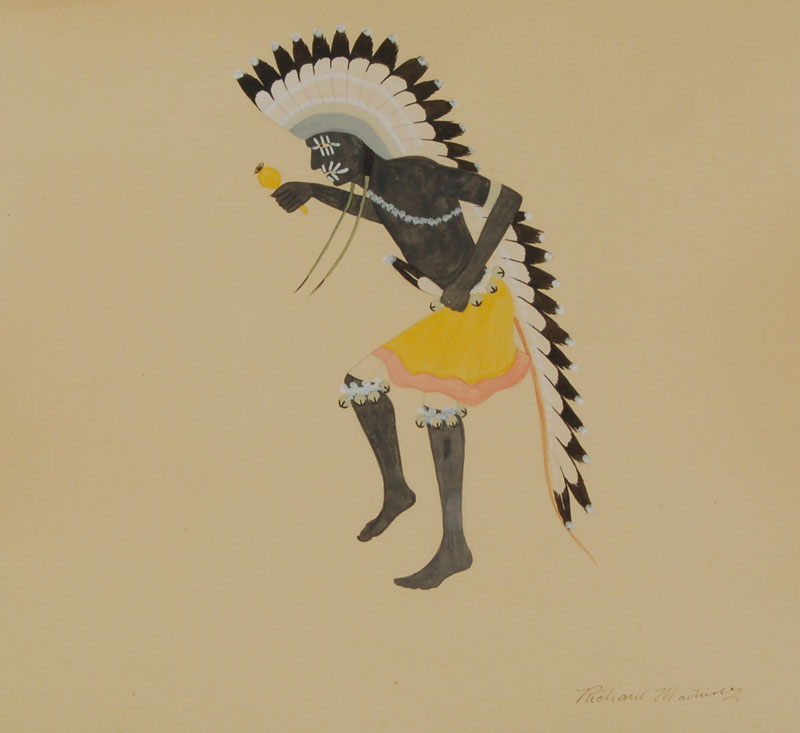 Richard Martinez was not one of the San Ildefonso Pueblo youngsters who attended the San Ildefonso Day School during 1900-1907 when the teacher at that time, Esther Hoyt, provided her students with paper and paints and encouraged them to paint subjects with which they were familiar such as ceremonial dancers in the plaza. Her classes were for students from age 5 to age 12. Martinez had been born in 1904 so was too young to reap the benefits of the teacher's generosity to her students even though it was against U. S. Government policy to encourage such acts.
Richard Martinez was not one of the San Ildefonso Pueblo youngsters who attended the San Ildefonso Day School during 1900-1907 when the teacher at that time, Esther Hoyt, provided her students with paper and paints and encouraged them to paint subjects with which they were familiar such as ceremonial dancers in the plaza. Her classes were for students from age 5 to age 12. Martinez had been born in 1904 so was too young to reap the benefits of the teacher's generosity to her students even though it was against U. S. Government policy to encourage such acts.
An Eagle Ceremony at Tesuque Pueblo by Gustave Baumann - C3838H
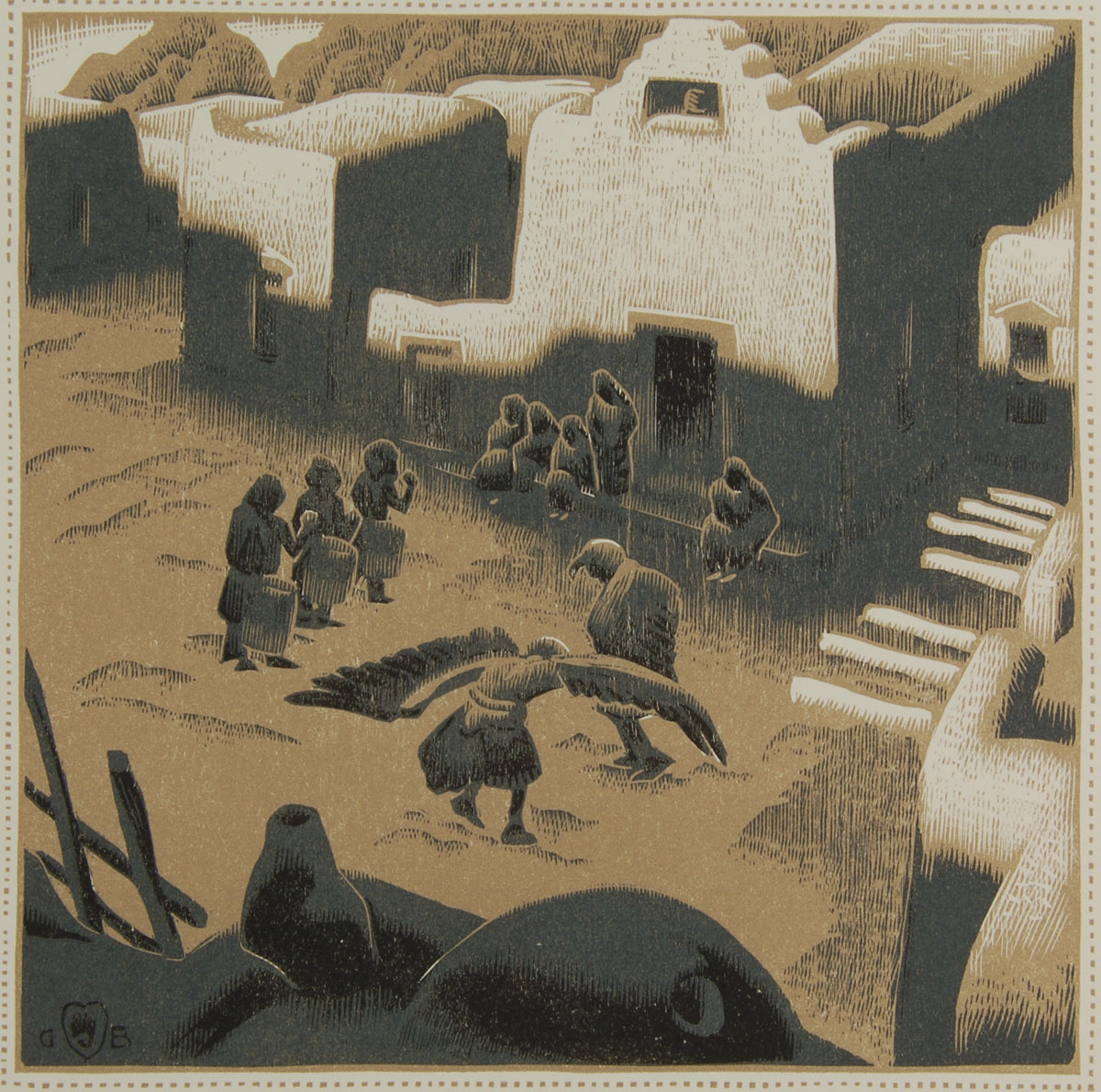 This Colophon print was printed from the original woodblock hand-carved by Gustave Baumann (1881-1971). None of the prints in Colophon were ever signed in pencil, but this one does include Baumann's initials and his monogram cypher of a hand palm in a heart in the lower left corner. No other editions of this woodcut were ever issued.
This Colophon print was printed from the original woodblock hand-carved by Gustave Baumann (1881-1971). None of the prints in Colophon were ever signed in pencil, but this one does include Baumann's initials and his monogram cypher of a hand palm in a heart in the lower left corner. No other editions of this woodcut were ever issued.
Navajo Sterling Silver and Turquoise Letter Opener, circa 1930s - C3838E
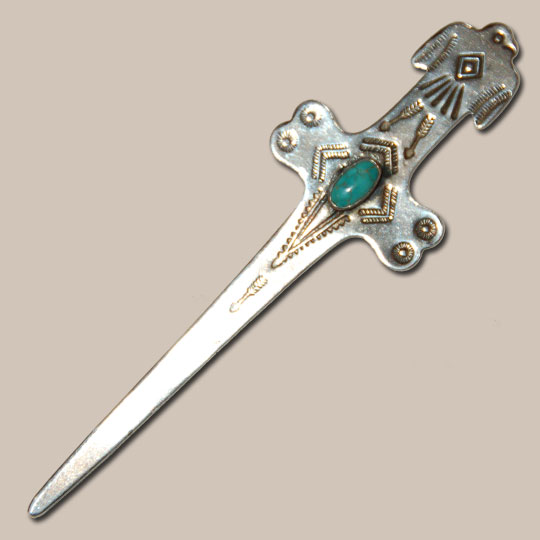 This sterling silver and turquoise letter opener has the stamp of The Maisel Company of Albuquerque. The Maisel Company had on-site Navajo and Pueblo jewelers working in the basement level of the store in Albuquerque. They could be viewed while working because there was a large oval cut out in the floor, through which clients could look down and see the artisans working.
This sterling silver and turquoise letter opener has the stamp of The Maisel Company of Albuquerque. The Maisel Company had on-site Navajo and Pueblo jewelers working in the basement level of the store in Albuquerque. They could be viewed while working because there was a large oval cut out in the floor, through which clients could look down and see the artisans working.
Santa Clara Pueblo Black Pottery Vessel by Greg Garcia - C3837B
 Greg Garcia claims heritage to two Tewa Pueblos of New Mexico-Santa Clara and Ohkay Owingeh. His mother was Lydia Tafoya of Santa Clara, daughter of Severa Tafoya. His father was Santiago Garcia of Ohkay Owingeh. Greg's sisters are Tina Garcia and Virginia Garcia, both of whom are well-known potters.
Greg Garcia claims heritage to two Tewa Pueblos of New Mexico-Santa Clara and Ohkay Owingeh. His mother was Lydia Tafoya of Santa Clara, daughter of Severa Tafoya. His father was Santiago Garcia of Ohkay Owingeh. Greg's sisters are Tina Garcia and Virginia Garcia, both of whom are well-known potters.
Greg was inspired to become a potter by his grandmother, Severa Tafoya, who was the mother of five female potters of distinction. He started working with the clay when he was only 14 years old. He was taught to follow all traditional methods of pottery production-gathering and cleaning clay, processing clay and building with coils, stone polishing and outdoor firing. He faithfully follows those traditions.
Polychrome Wedding Vase from Acoma Pueblo by Lucy M. Lewis - C3658B
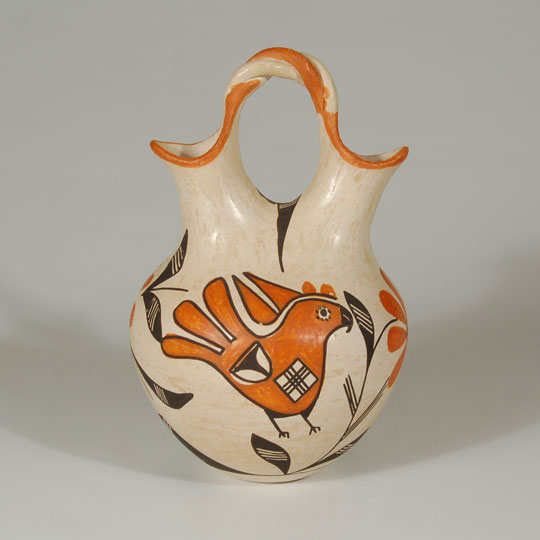 Travelers to New Mexico who have been to Acoma Pueblo are familiar with the original village atop the mesa known today as Sky City. It was on top of that mesa in 1898 that Lucy Martin Lewis was born and it was there that she grew up without the benefit of going to school. It was there also that she was struck by lightning in the 1960s. There was little hope that she would ever work again, but with perseverance she regained her muscle strength and went on to become one of the most recognized potters at Acoma Pueblo.
Travelers to New Mexico who have been to Acoma Pueblo are familiar with the original village atop the mesa known today as Sky City. It was on top of that mesa in 1898 that Lucy Martin Lewis was born and it was there that she grew up without the benefit of going to school. It was there also that she was struck by lightning in the 1960s. There was little hope that she would ever work again, but with perseverance she regained her muscle strength and went on to become one of the most recognized potters at Acoma Pueblo.
Santa Clara Pueblo Bear Paw Jar by Nathan and Mela Youngblood - C3657A
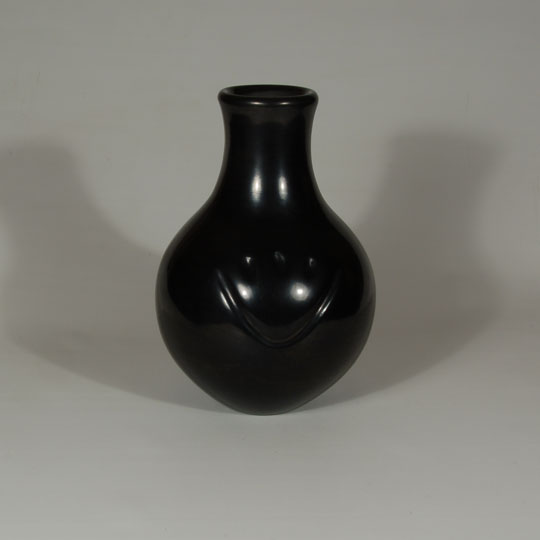 This polished Santa Clara Pueblo black jar with a bear paw design was made by Mela Youngblood and her son Nathan Youngblood and was signed by both artists. Very few pottery items were made by them together, maybe less than a half-dozen. This, indeed, is a rare item.
This polished Santa Clara Pueblo black jar with a bear paw design was made by Mela Youngblood and her son Nathan Youngblood and was signed by both artists. Very few pottery items were made by them together, maybe less than a half-dozen. This, indeed, is a rare item.
Sterling Silver and Green Turquoise Navajo Letter Opener - C3838F
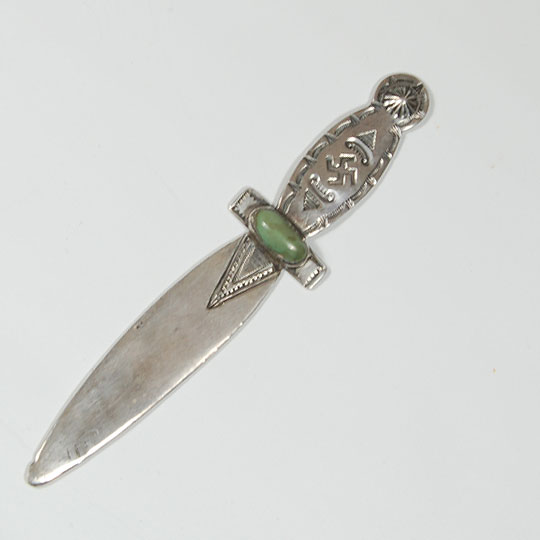 The Whirling Log symbol, often referred to as a Swastika, had a long tradition of use among many Native American tribes before the advent of its use by Hitler in the 1930s. I am unsure if the United States government forbade its continued use or if the Native tribes discontinued it on their own. I recall also that the yearbook of New Mexico State University had a row of the symbol on its cover in earlier years. Of course, it will never again be used on Native art but there are early items still around in which it appears and there are individuals who collect such items because of their historical importance to the art of Natives.
The Whirling Log symbol, often referred to as a Swastika, had a long tradition of use among many Native American tribes before the advent of its use by Hitler in the 1930s. I am unsure if the United States government forbade its continued use or if the Native tribes discontinued it on their own. I recall also that the yearbook of New Mexico State University had a row of the symbol on its cover in earlier years. Of course, it will never again be used on Native art but there are early items still around in which it appears and there are individuals who collect such items because of their historical importance to the art of Natives.
Santa Clara Pueblo Tall Black Bear Paw Jar by Sharon Naranjo Garcia - C3837A
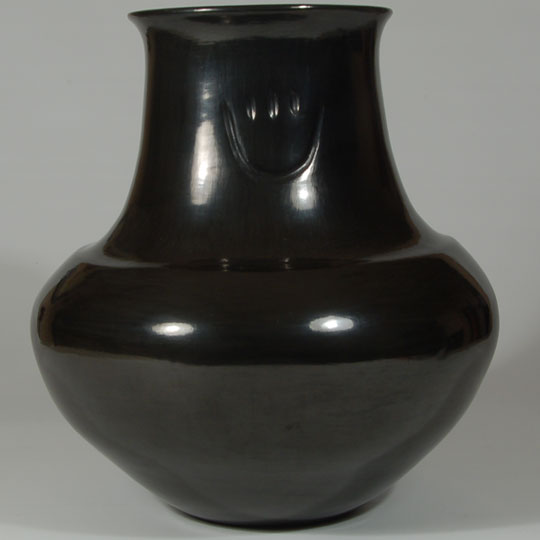 Many of today's potters began working with clay while very young. Most learned the art of making pottery from an adult family member. Sharon Naranjo Garcia (1951 - ) is no exception. She was raised by her grandmother, Christina Naranjo, and began making small animals using her grandmother's clay. From there, she developed into a full-fledge potter.
Many of today's potters began working with clay while very young. Most learned the art of making pottery from an adult family member. Sharon Naranjo Garcia (1951 - ) is no exception. She was raised by her grandmother, Christina Naranjo, and began making small animals using her grandmother's clay. From there, she developed into a full-fledge potter.
Painting of Navajo Couple in their Buckboard by Robert Chee - C3837G
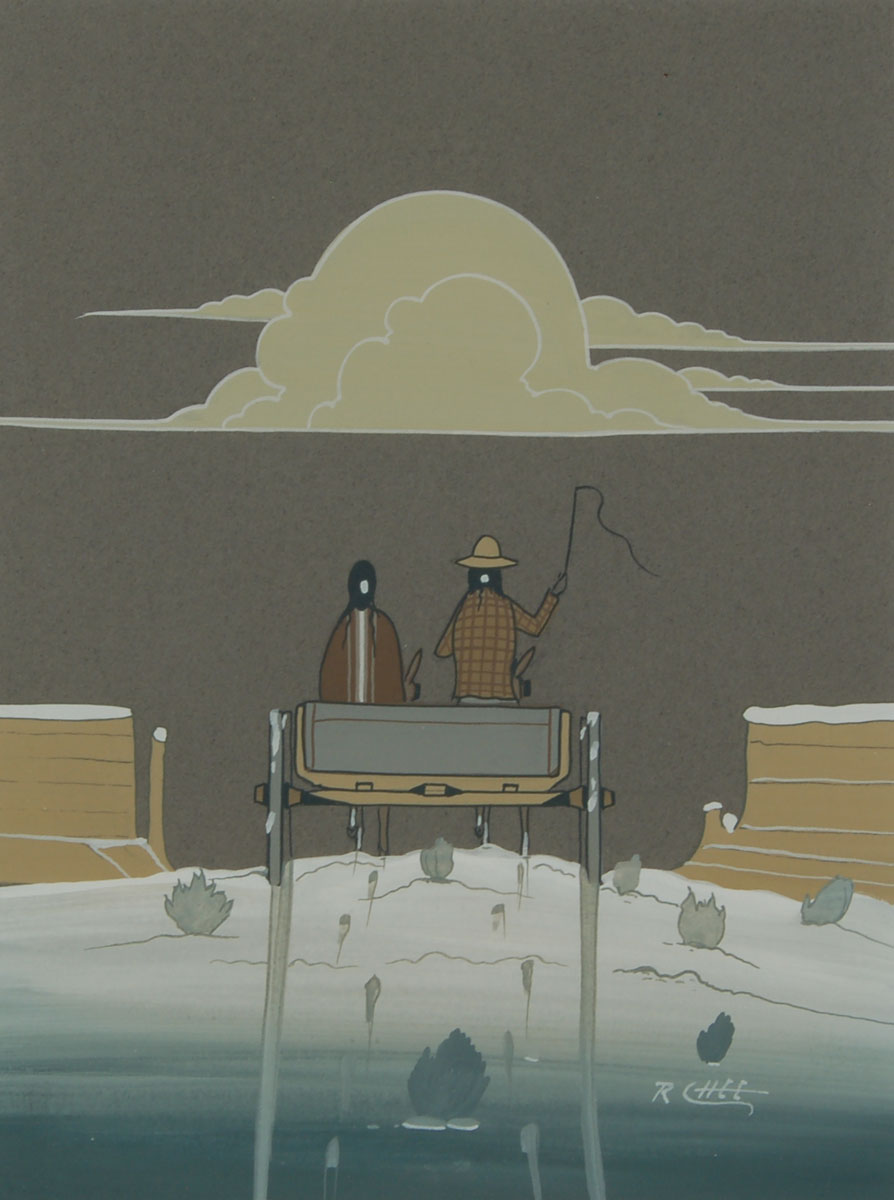 Robert Chee (1937-1971) Hashke-Yil-e-Cale has presented a nostalgic memory of the Navajo days of old when there were buckboards instead of pickup trucks. This is such a beautifully presented family portrait. The lines are simple but definitive in setting the scene. The clouds overhead and the dark sky set the scene for pending nightfall and the couple is quite likely returning to its hogan after visiting the trading post to possibly sell a Navajo rug or pawn some Navajo jewelry. The buttes framing the edges of the painting define the features of the Navajo Reservation. Snow on the buttes and ground reveal the cold winters experienced on the Reservation.
Robert Chee (1937-1971) Hashke-Yil-e-Cale has presented a nostalgic memory of the Navajo days of old when there were buckboards instead of pickup trucks. This is such a beautifully presented family portrait. The lines are simple but definitive in setting the scene. The clouds overhead and the dark sky set the scene for pending nightfall and the couple is quite likely returning to its hogan after visiting the trading post to possibly sell a Navajo rug or pawn some Navajo jewelry. The buttes framing the edges of the painting define the features of the Navajo Reservation. Snow on the buttes and ground reveal the cold winters experienced on the Reservation.
SPECIAL EXHIBIT: NACIMIENTO - NOW OPEN, Join us and explore the wonderful world of Nacimientos.
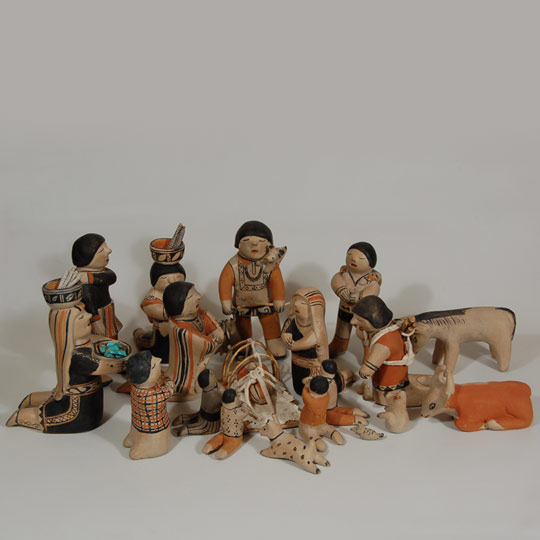 Since the 1970s, nativity sets have been popular with collectors as highlights of their Christmas decorating theme. These popular folk art pottery sets feature the Christian celebration of the birth of Jesus with a decidedly Native American twist. Adobe Gallery continues its holiday tradition begun in 1979 of exhibiting pueblo pottery "Nacimientos" or nativity sets made by New Mexico pueblo potters.
Since the 1970s, nativity sets have been popular with collectors as highlights of their Christmas decorating theme. These popular folk art pottery sets feature the Christian celebration of the birth of Jesus with a decidedly Native American twist. Adobe Gallery continues its holiday tradition begun in 1979 of exhibiting pueblo pottery "Nacimientos" or nativity sets made by New Mexico pueblo potters.
In their own tradition, the Indian artisans have made the figurines in the likeness of Indians. The Blessed Mother may wear her hair up in a "chonga", be wrapped in an Indian blanket, and be wearing moccasins. Joseph may have long, wrapped braids, moccasins and an Indian sash. The Three Wise Men may bring gifts of Indian bread, green chilies, a rabbit, or maybe a bowl of stew or several ears of corn. Baby Jesus may be dressed in beaded buckskin or wrapped in an Indian blanket. The animals around the manger may be black bears, deer, antelope or rabbits.
The artists represented here are:
Helen Cordero - Cochiti Pueblo
Ada Suina - Cochiti Pueblo
Seferina Ortiz - Cochiti Pueblo
Felicita Eustace - Cochiti Pueblo
Snowflake Flower - Cochiti Pueblo
Original Loloma Stone Lithograph “Father Lizard” by Charles Loloma - C3838J
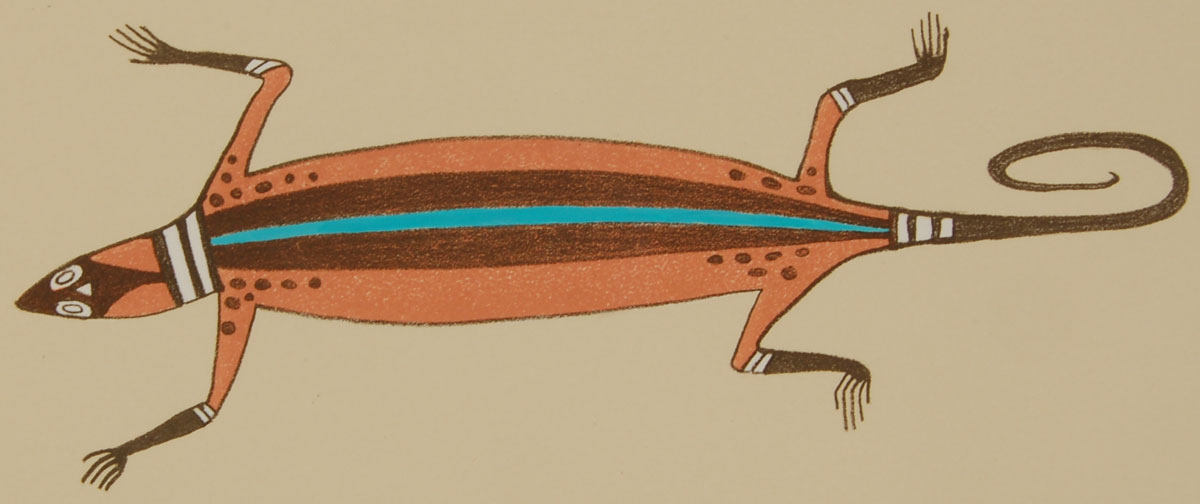 Charles Loloma is best known for his impact on Indian jewelry design, but, before venturing into jewelry design, he was first a ceramicist and a painter. While attending High School at the Village of Oraibi on the Hopi Reservation, he studied under the well-known Hopi artist Fred Kabotie. He attended the Phoenix Indian School and, while still a student, was selected by Kabotie to assist in the reproduction of the Awatovi murals for the Museum of Modern Art in New York.
Charles Loloma is best known for his impact on Indian jewelry design, but, before venturing into jewelry design, he was first a ceramicist and a painter. While attending High School at the Village of Oraibi on the Hopi Reservation, he studied under the well-known Hopi artist Fred Kabotie. He attended the Phoenix Indian School and, while still a student, was selected by Kabotie to assist in the reproduction of the Awatovi murals for the Museum of Modern Art in New York.
Original Loloma Stone Lithograph “Medicine Man” by Charles Loloma - C3838L
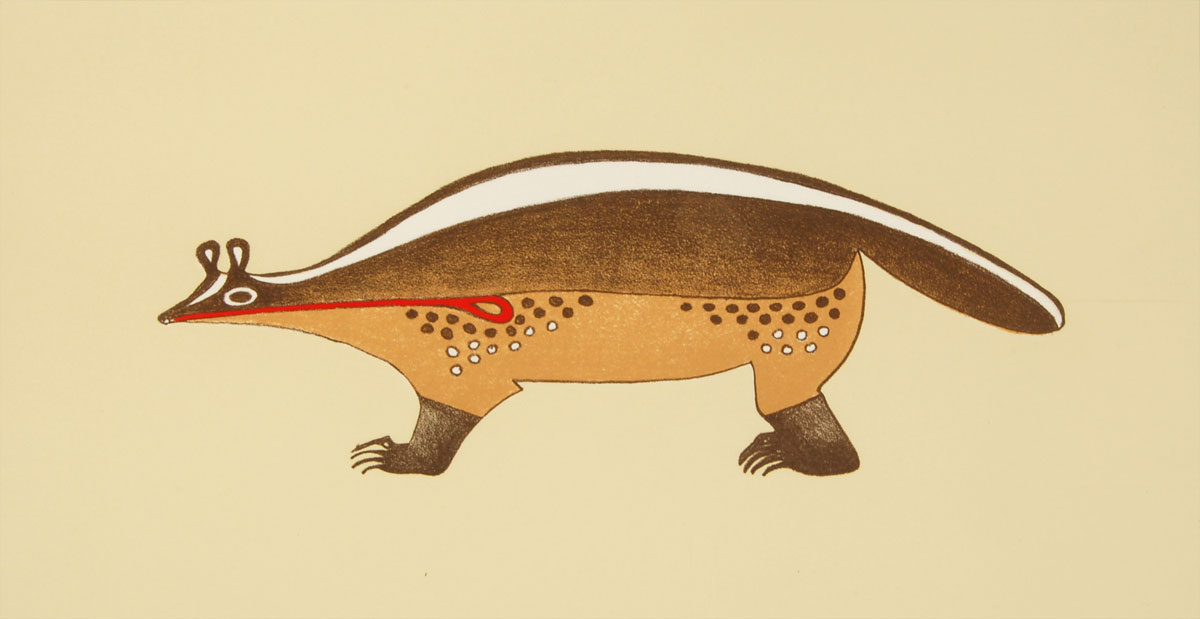 This image, which Charles Loloma labeled "Medicine Man," was executed as a stone lithograph. which is a process by which an artist draws an image with a crayon on a large flat stone that has a smooth surface. Rosin and talc are then brushed on the image to protect and prepare it for the etching process. An acidified gum Arabic solution is then spread over the image. It reacts with the crayon to produce a "grease reservoir" which will accept the ink in the printing process. In the surface areas where there is no crayon, the solution leaves a water absorbent gum jacket which resists ink. After processing, the printer washes out the crayon with a solvent and rolls printing ink over the image.
This image, which Charles Loloma labeled "Medicine Man," was executed as a stone lithograph. which is a process by which an artist draws an image with a crayon on a large flat stone that has a smooth surface. Rosin and talc are then brushed on the image to protect and prepare it for the etching process. An acidified gum Arabic solution is then spread over the image. It reacts with the crayon to produce a "grease reservoir" which will accept the ink in the printing process. In the surface areas where there is no crayon, the solution leaves a water absorbent gum jacket which resists ink. After processing, the printer washes out the crayon with a solvent and rolls printing ink over the image.
Original Loloma Stone Lithograph “Mudheads” by Charles Loloma - C3838K
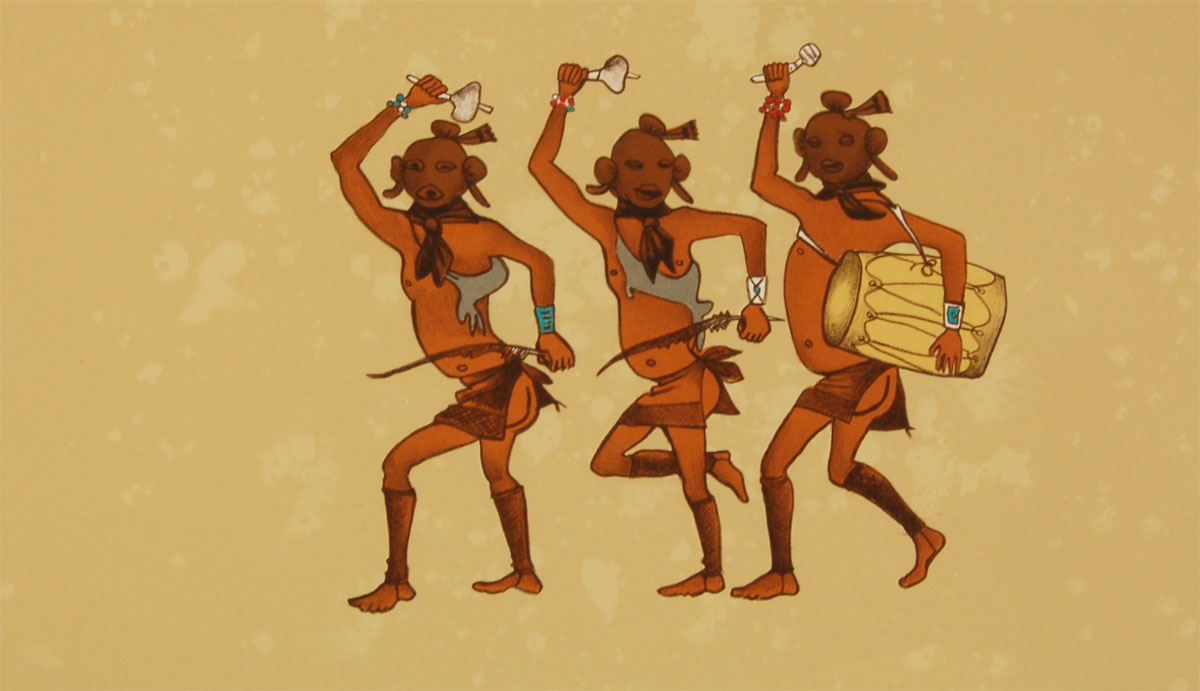 Charles Loloma is most famous for his imaginative jeweler but he also was a painter, a sculptor, a potter, a basket maker, a designer of houses and a stained glass artist. He then became a lithographer in 1980.
Charles Loloma is most famous for his imaginative jeweler but he also was a painter, a sculptor, a potter, a basket maker, a designer of houses and a stained glass artist. He then became a lithographer in 1980.
Loloma was born in the village of Hotevilla on the Hopi Reservation in 1920. His father was a weaver and his mother a basket maker. As a child, he began painting and by the time he graduated from High School, he had already illustrated a book for Edward Kennard. Loloma's jewelry made him a famous and wealthy man but it did not quench his thirst for finding another manner of expressing his artistic talents.
Original Loloma Stone Lithograph “Qöqöle” by Charles Loloma - C3838i
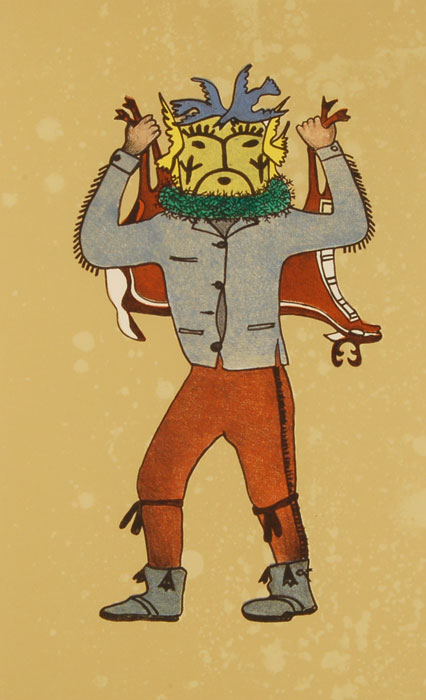 Charles Loloma is internationally known for his outrageously beautiful jewelry creations, but he was equally talented in making pottery and in paintings and lithography. He has often been overlooked in these latter categories, but he should not be. Multi-talented artists who are equally at ease in various mediums are not the norm. Some who come to mind are Michelangelo, Leonardo de Vinci, Allan Houser, and Charles Loloma. Of course there are others, but these stand out in most people's minds.
Charles Loloma is internationally known for his outrageously beautiful jewelry creations, but he was equally talented in making pottery and in paintings and lithography. He has often been overlooked in these latter categories, but he should not be. Multi-talented artists who are equally at ease in various mediums are not the norm. Some who come to mind are Michelangelo, Leonardo de Vinci, Allan Houser, and Charles Loloma. Of course there are others, but these stand out in most people's minds.
Tohono O´odham Shallow Basketry Bowl with Star Design - 24768
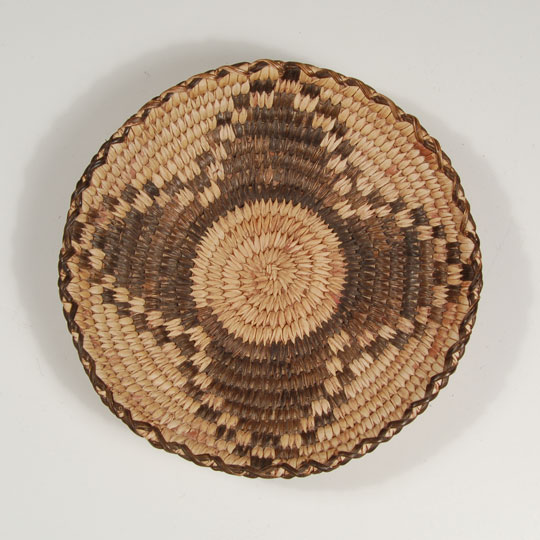 The name for the Papago Indians comes from the Pima word Papavi-ootam, meaning "Bean People," which was converted to Papago by the Spaniards. The people have, in the last few decades, returned to their original tribal name, Tohono O'odham. The word used by tribal members for themselves is Aw-aw-tam, meaning "the people."
The name for the Papago Indians comes from the Pima word Papavi-ootam, meaning "Bean People," which was converted to Papago by the Spaniards. The people have, in the last few decades, returned to their original tribal name, Tohono O'odham. The word used by tribal members for themselves is Aw-aw-tam, meaning "the people."
Dyes are not used in their baskets. The materials are used in their natural colors. The foundation is comprised of bear grass and the covering materials are yucca leaves, in a sun-bleached state, and devil's claw for the brown decoration.
Papago Shallow Basketry Bowl with Flower Design - 24767
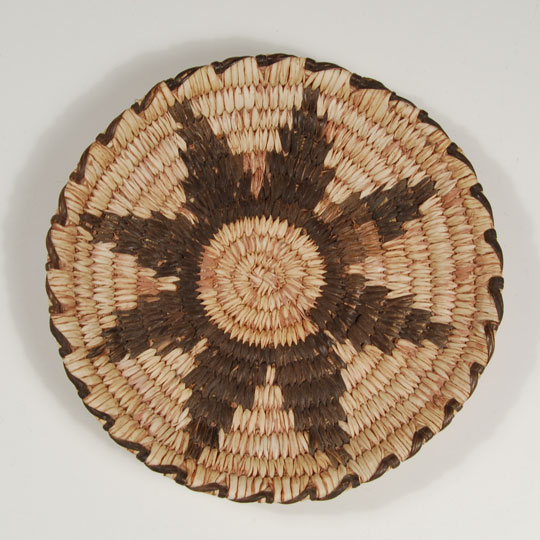 Basketry is the oldest of all Indian crafts which still exists today. Most tribes made baskets of various sizes and shapes for their own use and then eventually began making smaller baskets for sale to tourists, visitors and collectors. It is often quite difficult to distinguish between baskets of the Tohono O'Odham and their neighbors the Akimel O'Odham because of the proximity of the two tribes and intermarriage amongst the members. Generally, the former's baskets have larger coils and looser stitches than those of the Akimel O'Odham, which generally are of finer stitch and finer quality.
Basketry is the oldest of all Indian crafts which still exists today. Most tribes made baskets of various sizes and shapes for their own use and then eventually began making smaller baskets for sale to tourists, visitors and collectors. It is often quite difficult to distinguish between baskets of the Tohono O'Odham and their neighbors the Akimel O'Odham because of the proximity of the two tribes and intermarriage amongst the members. Generally, the former's baskets have larger coils and looser stitches than those of the Akimel O'Odham, which generally are of finer stitch and finer quality.
Mixed Media Painting “Turtle Walk” by David Dawangyumptewa - C3624H
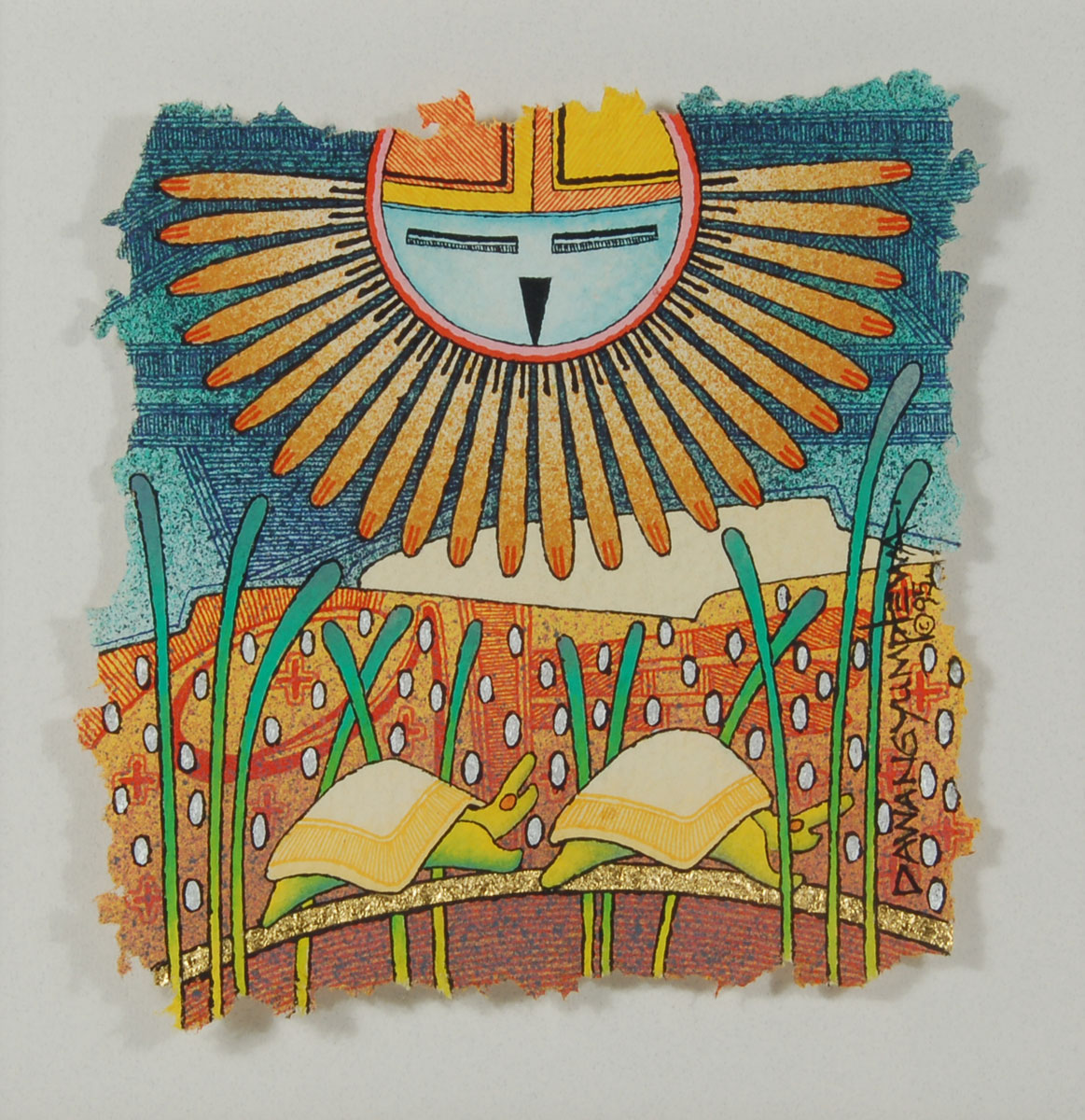 In this amazingly detailed gouache painting, David Dawangyumptewa presents a tranquil scene of a pair of turtles slowly walking through blades of grass with a beautiful colorful Sun image looking down on them. The painting was executed in gouache with gold leaf and silver paints on handmade paper with deckled edges. The images flow to the edges of the paper.
In this amazingly detailed gouache painting, David Dawangyumptewa presents a tranquil scene of a pair of turtles slowly walking through blades of grass with a beautiful colorful Sun image looking down on them. The painting was executed in gouache with gold leaf and silver paints on handmade paper with deckled edges. The images flow to the edges of the paper.
Navajo Sterling Silver Lidded Pill Box - C3838A
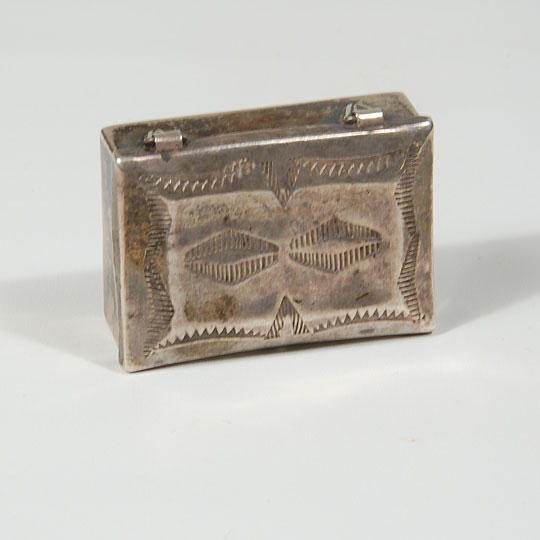 When the railroad came to New Mexico in 1880, it brought with it tourists eager to purchase souvenirs to remind them of their adventure west. By the early 20th century, Fred Harvey had built a chain of hotels along the railroad catering to the tourist trade. Making items to satisfy this new and growing market became a profitable business for the Navajo silversmith. Items such as combs and hair ornaments, brooches of all types, tie tacks and clips, pendants, cuff links, watchbands, key chains, silver tobacco flasks, and silver pill boxes, as well as other items became very popular with the buying public.
When the railroad came to New Mexico in 1880, it brought with it tourists eager to purchase souvenirs to remind them of their adventure west. By the early 20th century, Fred Harvey had built a chain of hotels along the railroad catering to the tourist trade. Making items to satisfy this new and growing market became a profitable business for the Navajo silversmith. Items such as combs and hair ornaments, brooches of all types, tie tacks and clips, pendants, cuff links, watchbands, key chains, silver tobacco flasks, and silver pill boxes, as well as other items became very popular with the buying public.
Small Navajo Square Sterling Silver Lidded Pill Box - C3838B
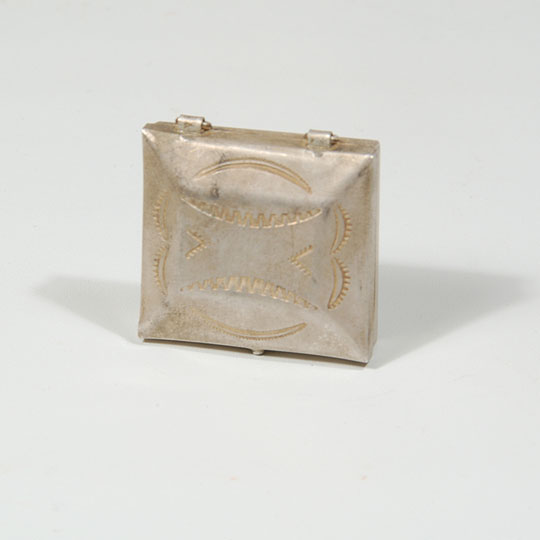 This is an older, probably circa 1950s, sterling silver lidded box with traditional stamping on the lid and handmade silver hinges on the back. This small box was constructed from sheet silver stock and has a beveled lid which is hinged to the box with a pair of handmade silver hinges. Sheet silver was introduced in the 1920s by the federal Arts and Crafts Board. The sheets are .925 fine and come in several thicknesses.
This is an older, probably circa 1950s, sterling silver lidded box with traditional stamping on the lid and handmade silver hinges on the back. This small box was constructed from sheet silver stock and has a beveled lid which is hinged to the box with a pair of handmade silver hinges. Sheet silver was introduced in the 1920s by the federal Arts and Crafts Board. The sheets are .925 fine and come in several thicknesses.
Navajo Sterling Silver and Turquoise Lidded Pill Box - C3838C
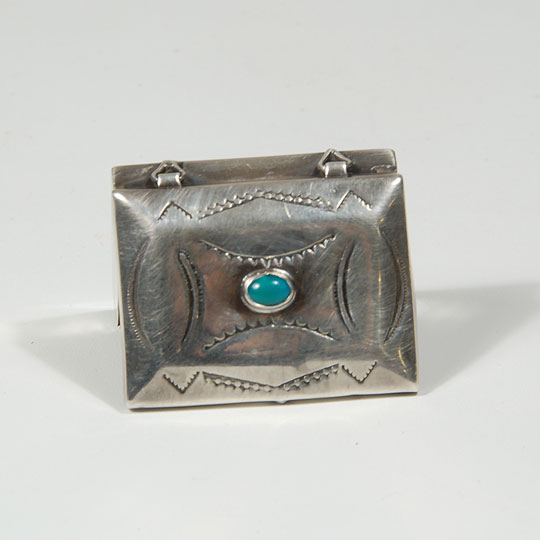 Silversmithing among the Navajo began sometime in the mid-1800s, possibly during the time of their internment at Bosque Redondo in southern New Mexico. The early days of silversmithing consisted of jewelry items such as bracelets, necklaces and earrings, and the source of silver was most often Mexican silver coins.
Silversmithing among the Navajo began sometime in the mid-1800s, possibly during the time of their internment at Bosque Redondo in southern New Mexico. The early days of silversmithing consisted of jewelry items such as bracelets, necklaces and earrings, and the source of silver was most often Mexican silver coins.
By the beginning of the 20th century, ingot silver and then sheet silver became the source of raw materials, and the demands of the buying public became the inspiration for ideas.

